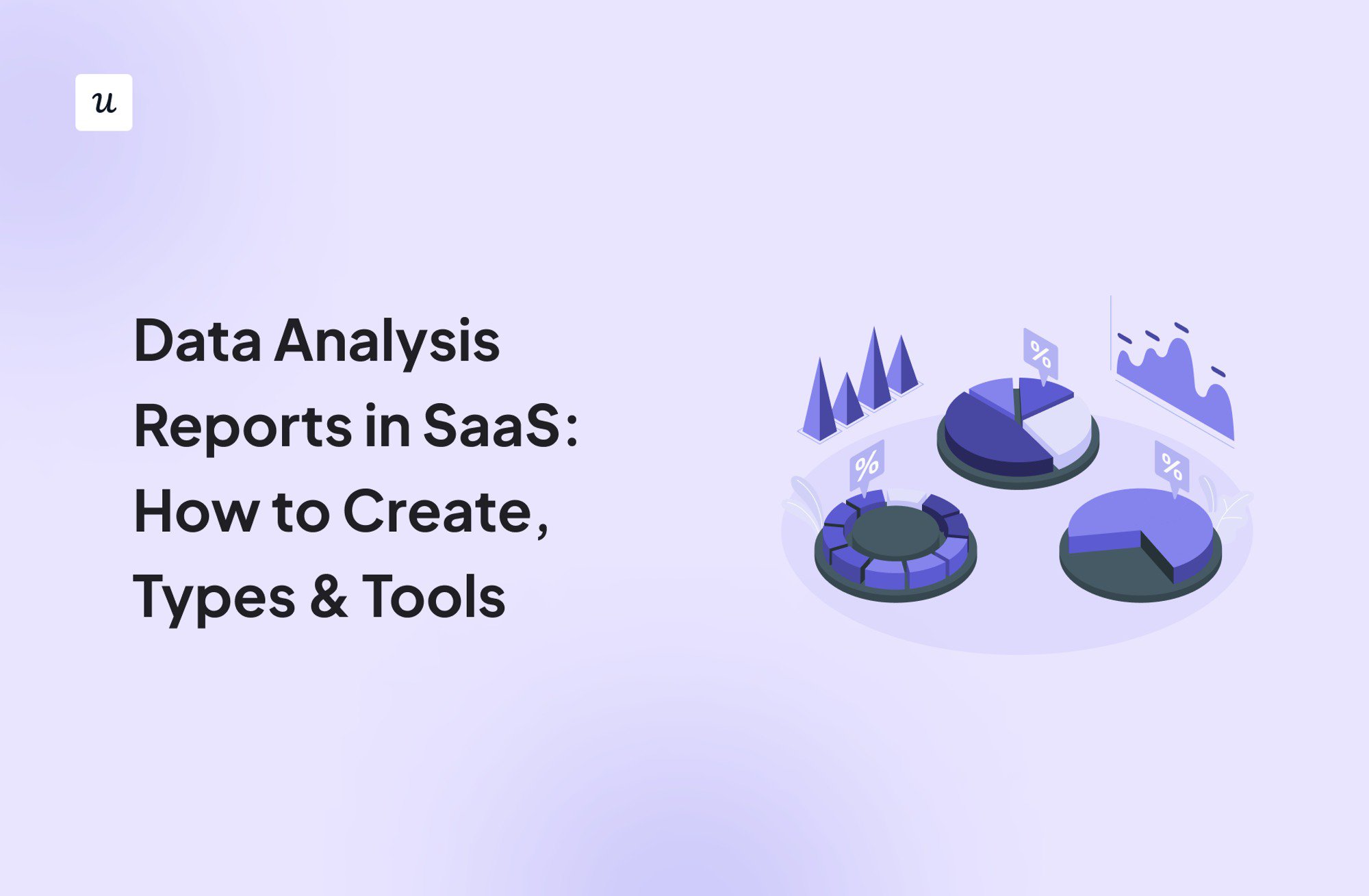
How do you create top-notch data analysis reports?
This is the article’s main question, so if you’re looking for the answer, you’re in the right place.
It also covers:
- Why you need data analysis reports.
- Different types of reports.
- Best analytics tools for creating data analysis reports.
Sounds interesting? Let’s get to it, then!
Try Userpilot Now
See Why 1,000+ Teams Choose Userpilot

What is data analysis?
In SaaS, data analysis is the process of collecting, analyzing, and interpreting user behavior and product performance data.
For example, you may want to analyze how users navigate your website, how they interact with different features, or how successful your product is at generating recurring revenue.
Data analysis aims to inform product and business decisions.
\
What is a data analysis report?
A data analysis report is a type of business report based on quantitative and qualitative data whose purpose is to communicate key trends and insights to stakeholders. Such reports are normally created manually by collating and interpreting data from multiple sources.
In the context of product analytics software, a data analysis report also refers to a view automatically generated by the tool. Such reports tend to focus on one specific aspect of product or website performance.
For example, the Backlinks report in Ahrefs, a well-known SEO tool, provides granular information about a website’s inbound links.
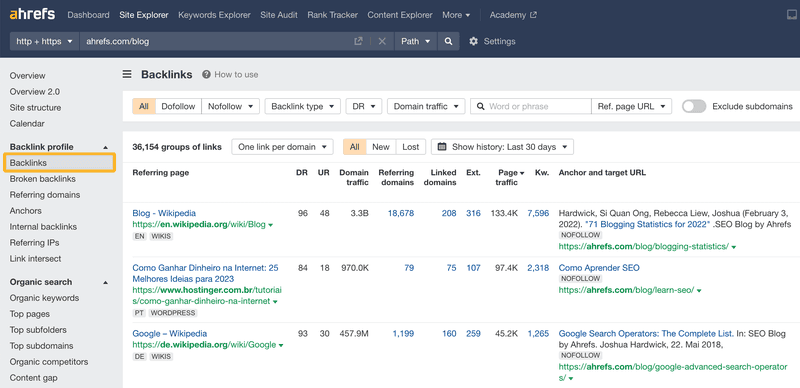
Backlinks analysis report in Ahrefs.
In the article, we focus mostly on this type of report.
Why are data analysis reports important?
Data analysis reports are essential for day-to-day product operations.
For starters, they enhance communication and collaboration between internal and external stakeholders. Sharing insights in the form of reports breaks up data silos and builds a shared understanding of key trends for better team alignment.
By facilitating data democratization, analytics reports also improve team productivity and efficiency. That’s because non-technical users don’t have to wait for the support of data analysts to make informed decisions.
Thanks to that, they can respond swiftly to shifts in customer needs and market trends, which gives them a competitive advantage.
Different types of data analysis reports in SaaS
In the next few sections, let’s look at a few common types of data analysis reports.
Please bear in mind, though, that an organization may need dozens of different analytical reports, and many manually written reports include elements of multiple types of reports.
Trend analysis report
Trend analysis report evaluates patterns, changes, and developments observed in data or information over time.
The primary purpose of such a report is to identify significant trends, understand their impact, and make informed decisions or predictions about future developments.
In SaaS, they’re widely used to track key performance indicators and identify relations between data sets or metrics. For example, you could use it to identify correlations between metrics.
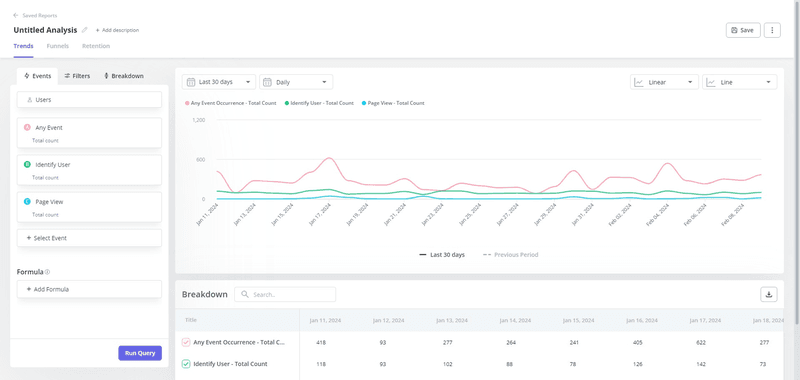
Key metrics to include in your trend analysis report
A trend analysis report is suitable for tracking all imaginable metrics at different stages of the customer journey, depending on your goals or focus.
For example, at the acquisition stage, you could track free trial sign-ups, demo bookings, or customer acquisition cost (CAC), while at the revenue stage, it could be customer lifetime value (CLV) or annual recurring revenue (ARR).
Data analysis report example for trends
The graph below illustrates product usage by device.
Such a report can help you spot shifts in user preferences and prioritize your optimization efforts effectively.
For example, if you discover that one type of device or platform is growing in popularity, you could divert your resources to prioritize the support for this particular device. This could be at the expense of another type of device whose popularity is declining.
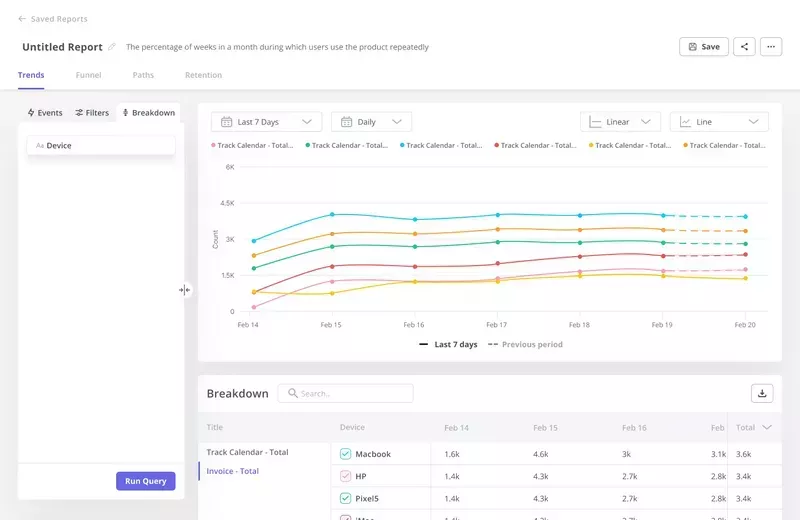
Funnel analysis report
Funnel analysis reports are tools for visualizing the customer or user flow through different stages of their relationship with the product.
The name comes from the shape of the chart illustrating the number of users progressing from one stage to another. As users gradually drop off at each stage, the bars representing subsequent stages get narrower toward the bottom, resembling a funnel.
The aim of the report is to help teams understand how users engage with the product along the journey and identify stages where they experience friction and drop off or slow down. This enables them to target optimization efforts at specific stages and, ultimately, improve conversion rates.

Key metrics to include in your funnel analysis report
There are 3 main metrics that funnel analysis normally includes:
- Conversion rate – the percentage of users progressing from one stage to another; it could also be used about the main conversion event at the end of the funnel, for example, activation or upgrade.
- Drop-off rate – the percentage of users who fail to complete a conversion event at a particular stage and disappear.
- Time to convert – the time it takes users to complete a stage in the journey; if it’s longer than expected, it could be an indication of friction.
Data analysis report example for funnels
Let’s imagine you’re struggling to activate your users.
To identify the potential causes, you run a funnel analysis.
The report reveals that only 82 out of 574 users started the onboarding process. The drop-off rate of 85.71% is pretty high, considering how crucial onboarding is for user activation.
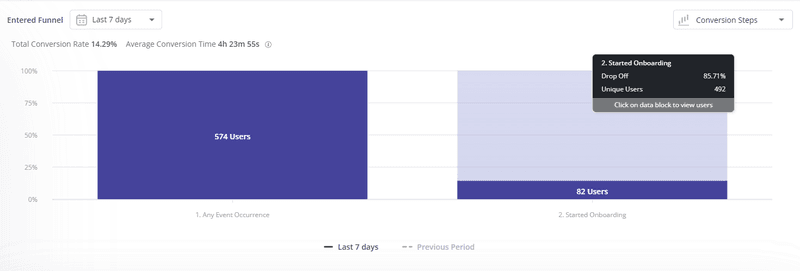
Moreover, you discover that it takes users almost 4.5 hours to start onboarding, which is way too long. For it to be effective, users should start it immediately.

Based on the insights, you create a welcome screen with a CTA button, which appears as soon as a new user logs in and triggers the product tour.
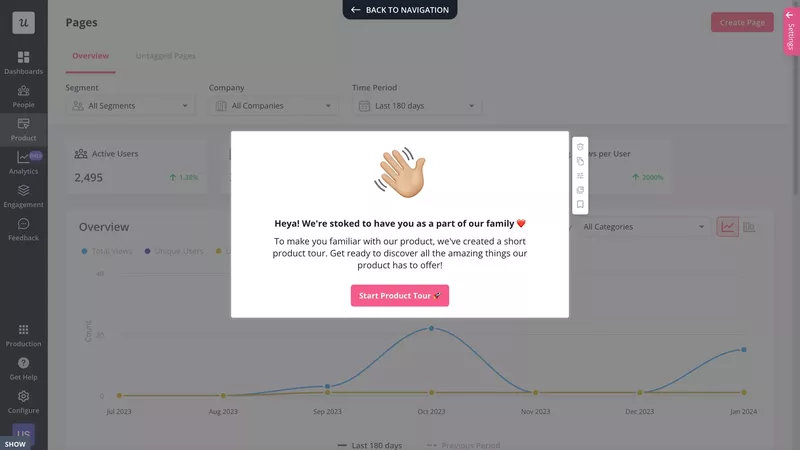
Path analysis report
Path analysis reports are used to map out user actions leading to or following an event or page view.
The path report uses a Sankey diagram to illustrate the user flow from one action or page to another. The thicker the band or arrow, the more users move in a particular direction.
SaaS teams can use this kind of report to:
- Obtain granular insights into user actions at each stage of the funnel.
- Identify friction points.
- Discover happy paths to conversion.
- Analyze the behavior of users who are at risk of churning.
- Identify behaviors that indicate the user is a good target for upsell efforts.
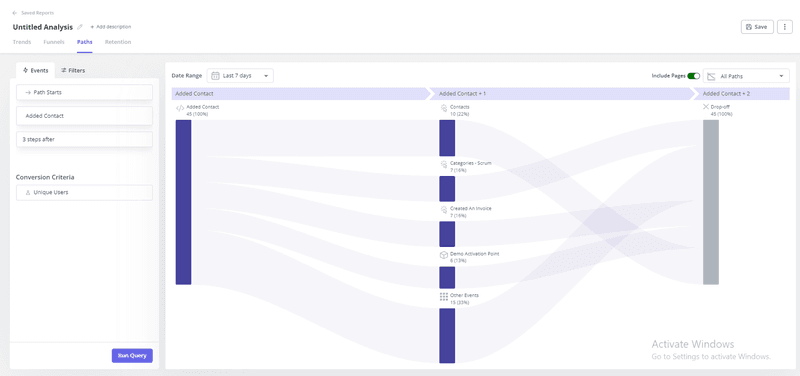
Key metrics to include in your path analysis report
The path analysis provides information about the user who completed each action. This is expressed as user count as well as percentage.
For example, in the diagram above, we can see that 7 users created an invoice, which amounts to 16% of the 45 who added a contact.
Data analysis report example for paths
Let’s continue with the example I first introduced for funnel analysis: the problem with user activation.
You’ve now managed to get users to start the product tour, but this increased activation marginally. As a result, you decide to tweak the product tour.
To do so, you analyze the paths of the users who managed to activate successfully. Visualizing the data as a top path reveals the happy path.
Now you can redesign the interactive tour so that it guides other users along the most optimal route.
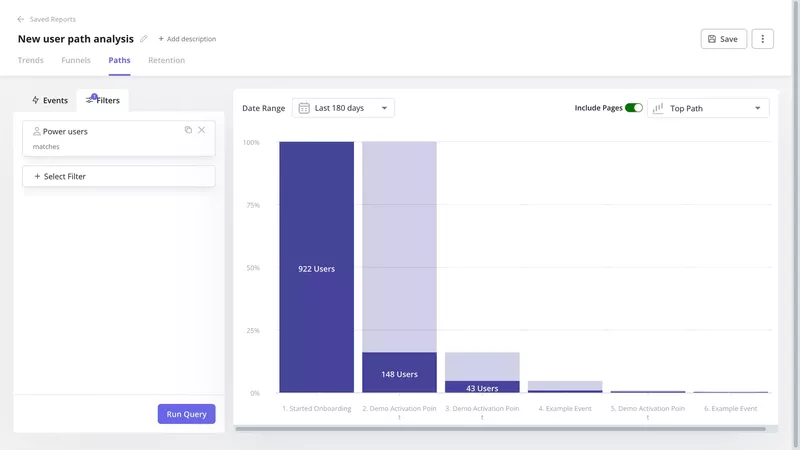
Customer retention report
A customer retention report illustrates retention trends over time for different user cohorts.
The main part of the report consists of a grid.
The Y-axis represents all the user cohorts who signed up for the product. A cohort could consist of users who did it on a particular day or in a particular week or month.
The X-axis represents the time since the sign-up. Again, this could be in daily, weekly, or monthly intervals.
The cells in the main part of the grid show the retention rate relative to the previous day/week/month.
Such reports provide valuable insights into:
- Patterns and trends in user retention.
- The impact of product changes on retention.
- Average engagement time.
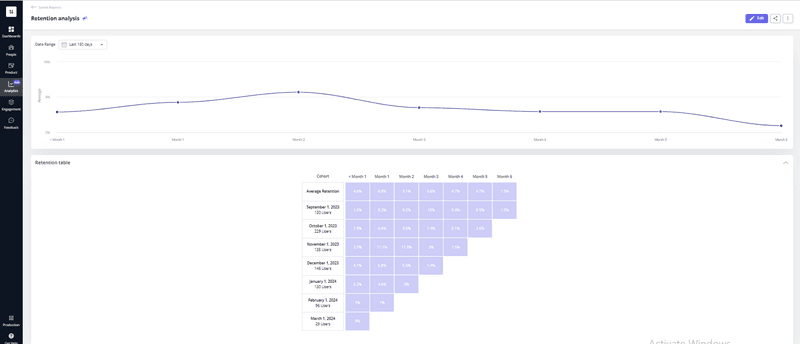
Key metrics to include in your retention analysis report
The two main metrics that you include in the retention analysis report are the retention rate and churn rate.
Sometimes, teams also look at the average engagement time, which is the time before users start losing interest in the product and dropping off.
Data analysis report example for retention cohorts
Let’s imagine that you have now overhauled your product tour and you can see improvement in the user activation.
The user retention report also shows that this has translated into a higher retention rate.
You can find it out by comparing the retention rates for user cohorts that signed up for the product before the onboarding changes and after their implementation.
How to create effective data analysis reports in 7 steps
Ready to create your data analysis reports? Here’s our 7-step guide.
Step 1. Establish clear objectives
The first step in product data analysis is usually goal setting.
This is essential to give your study adequate focus, choose the right methods, and track progress.
Here’s an example of a good goal: “Improve user activation by 47% in 6 months”.
To set this goal, I used the SMART framework.
SMART stands for:
- Specific (improve user activation).
- Measurable (by 47%).
- Achievable (Attention Insight managed to achieve it with Userpilot).
- Relevant (we’re having an issue with that and it’s impacting business performance).
- Time-bound (6 months).
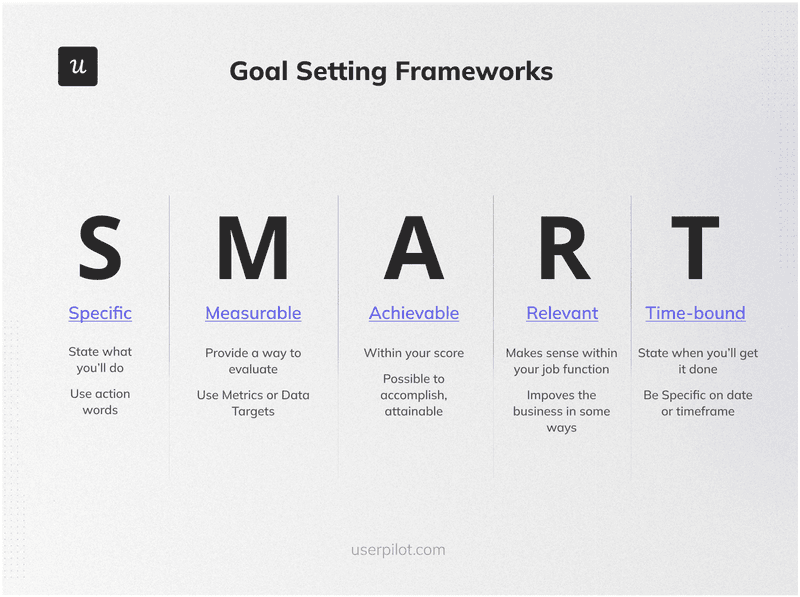
Other popular goal-setting frameworks you could use include OKR and BHAR.
Step 2. Collect data
Collecting the relevant data comes next.
In most analytics products, this is done by tagging features or creating events to track.
No-code analytics platforms, like Userpilot, allow you to do it from the front end, while others require attaching JS script to each tracked feature or event.
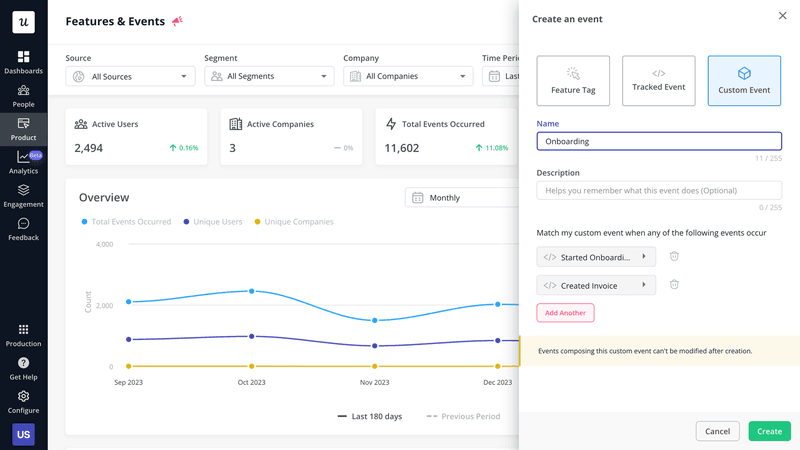
Step 3. Decide on your data analysis report type and metrics
Based on your goals, choose the type of analytical report and metrics to track.
For example, if you’re aiming to improve the activation rate, you may need the funnel analysis report and path analysis report to identify friction points.
The metrics to track could include sign-up count, activation rate, onboarding completion rate, and conversion rates at each stage of the onboarding flow and time to value.
Step 4. Use a data analysis report template
If you’re creating your report manually, it might be a good idea to find a report template and customize it to your needs.
Alternatively, you can use the ready-made reports and dashboards supported by your analytics platform.
For example, Userpilot offers 4 different reports (Trends, Funnels, Paths, Retention) and 4 dashboards (Product Usage, New Users Activation, Core Feature Engagement and User Retention).
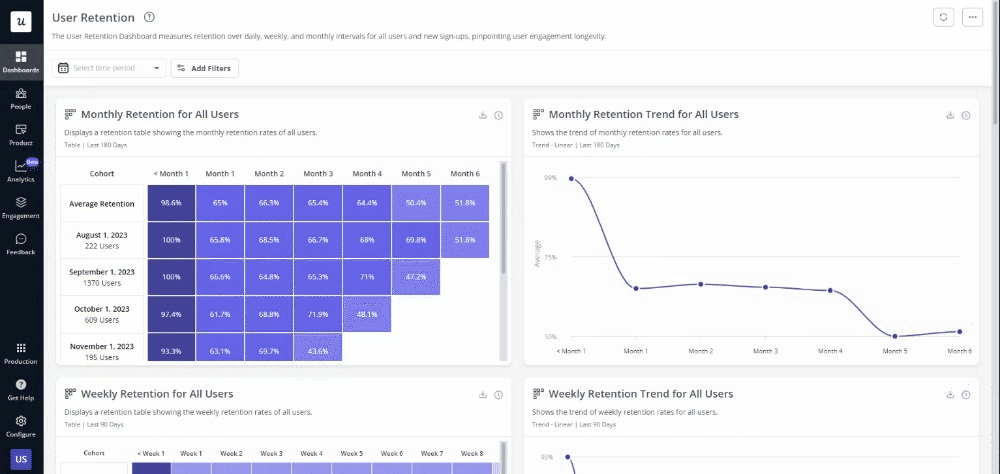
Step 5. Add events the report will be based on
If you decide to use the data analysis reports from your analytics platform, you next need to choose the events that the report will be based on.
For instance, for the funnel analysis, this is the conversion events at the end of each stage, for path analysis – the start or end event, and for retention analysis, the events that the user needs to complete to be considered retained.
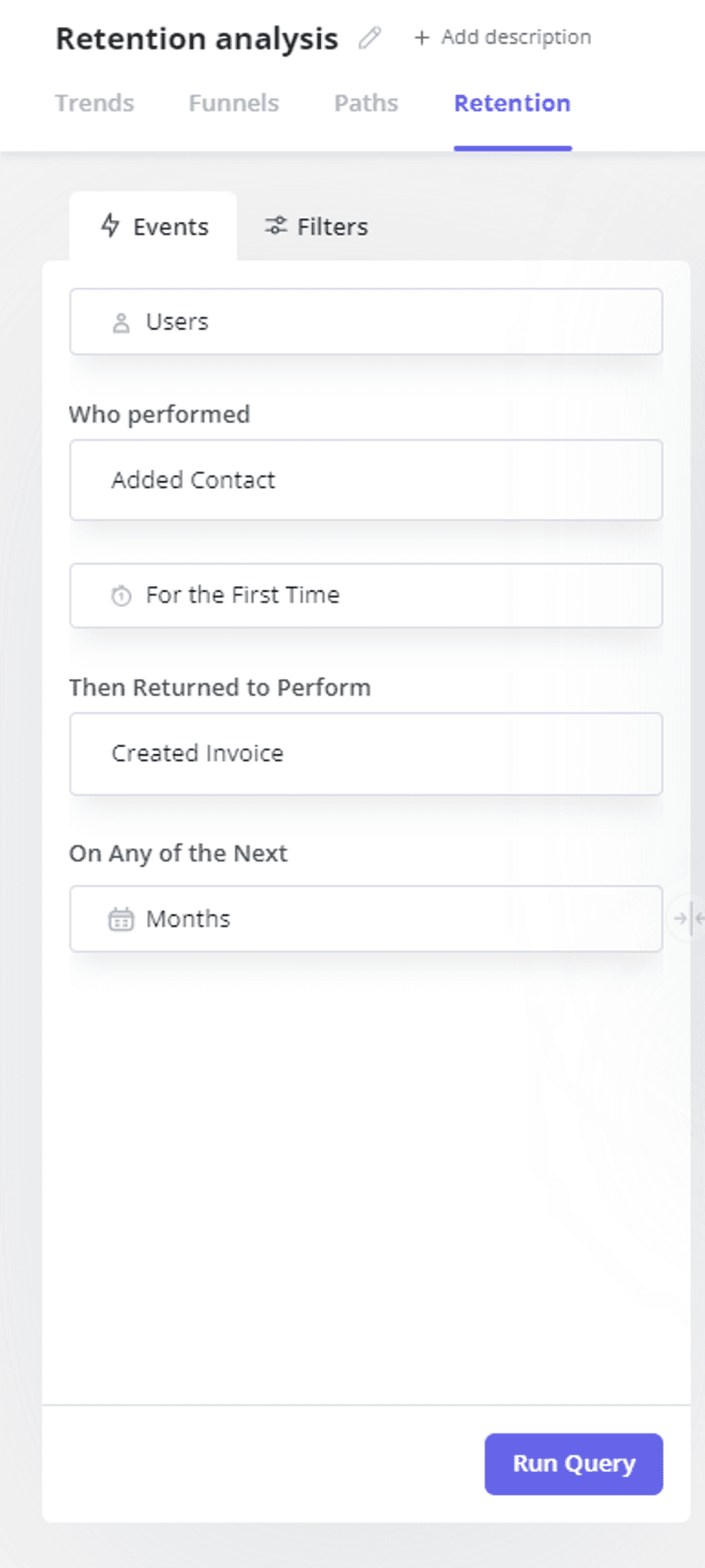
Step 6. Visualize data
Data visualization is the next step. Graphs, charts, and diagrams are much easier to analyze and interpret than raw data in tables. They’re also perfect for communicating key insights.
Different analytics tools offer various visualization options for various reports. Which ones you choose depends again on your objectives.
For instance, in the Funnels report in Userpilot you can choose between:
- Conversion steps – suitable for analyzing conversions across all stages.
- Conversion trends – the overall funnel conversion rate trend.
- Time to convert – when you’re trying to reduce time to value or time to adoption.
- Metric – to focus on the overall conversion rate.
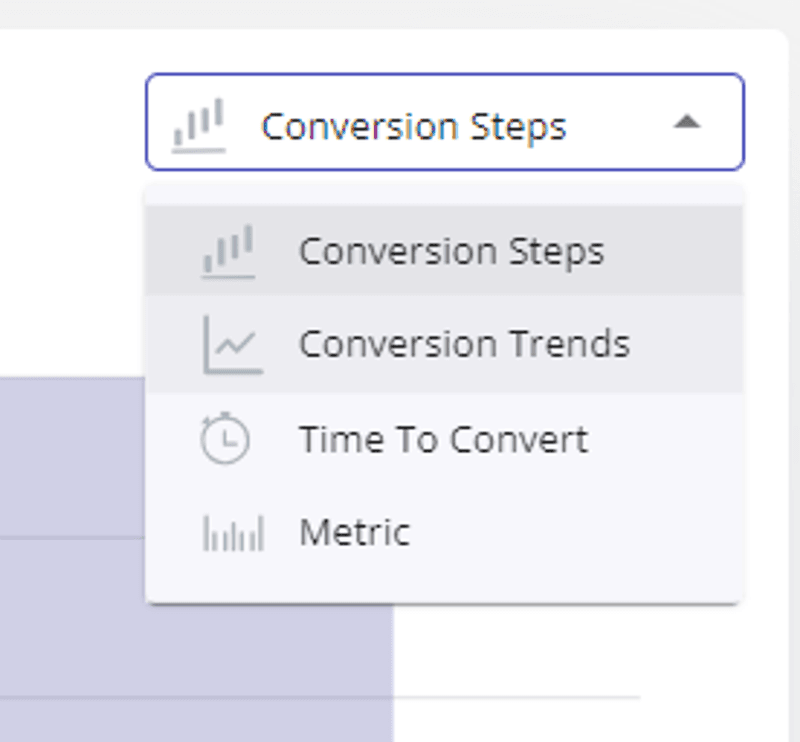
Step 7. Take a look at the analysis report for insights
Having generated the report and tailored data visualization to your objectives, it’s time to analyze and interpret the data.
Sometimes, finding meaningful insights is straightforward.
For instance, if you can see that one bar in the funnel report is considerably narrower than the previous one, that’s where users face bottlenecks.
Other times, you may need to dig deeper into the data. For example, the drop-off rate may not be too bad, but the time to convert could indicate friction, and you won’t be able to see it from the chart.
How successful the analysis is depends a lot on your experience.
Fortunately, for users with limited experience in data analytics, more and more tools provide AI-powered analytics features. They help users analyze historical data to extract insights and make predictions.
Such capabilities will be available in Userpilot soon.
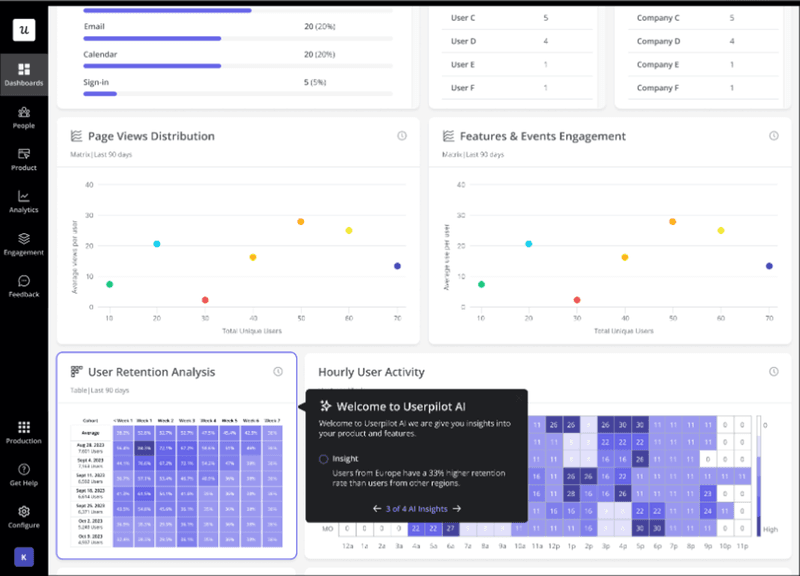
Best analytical tools for generating data analysis reports
There are plenty of dedicated product analytics tools, business intelligence solutions, and digital adoption platforms with analytics capabilities that you can use for data analysis reporting.
Let’s look at 3 options we believe are worth attention.
Userpilot: Best for collecting and visualizing quantitative and qualitative data in-app
Userpilot offers powerful analytics features.
As mentioned, you can use it for:
- Feature and event tracking.
- Funnel analysis.
- Path analysis.
- Trend analysis.
- Retention analysis.
It also offers 4 out-of-the-box analytics dashboards, and you will soon be able to create custom ones.
Want to know the best part?
Userpilot is not an analytics tool but a product adoption platform, so you can use it to collect user feedback for a more comprehensive understanding of user behavior and to design in-app experiences to drive user engagement and improve user experience.
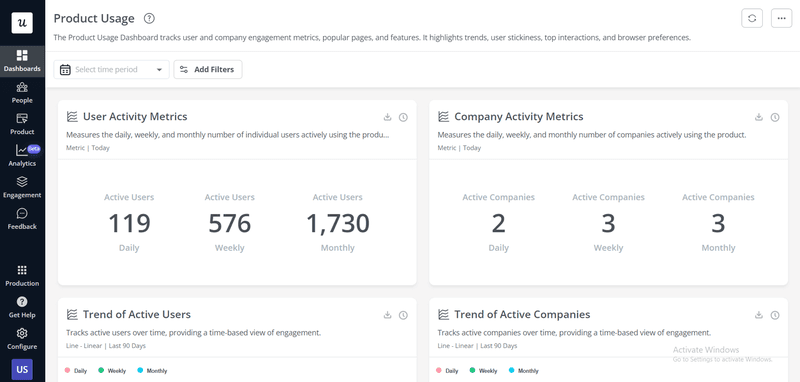
Google Analytics: Best for gaining insights into user behavior and website performance
Google Analytics is probably the best web analytics platform. I mean it can also track user behavior inside products, but most teams use it for tracking web page views.
GA offers similar reporting features as Userpilot:
- Trend analysis.
- Funnel exploration.
- Path exploration.
- Retention exploration.
In addition, it supports:
- User and traffic acquisition reports.
- Engagement reports.
- Monetization reports (for e-commerce sites).
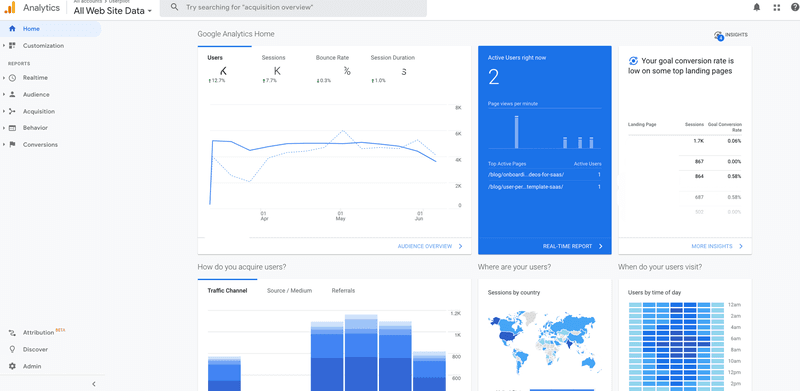
Tableau: Best for data visualization
Tableau is a versatile data visualization tool that enables SaaS teams to create interactive and shareable dashboards. Thanks to this, you can transform raw data into an easily understandable format without the need for any technical or programming skills.
The platform is widely used for business intelligence, data analysis, and reporting, making it easier for decision-makers to see and understand trends, patterns, and insights within their data.
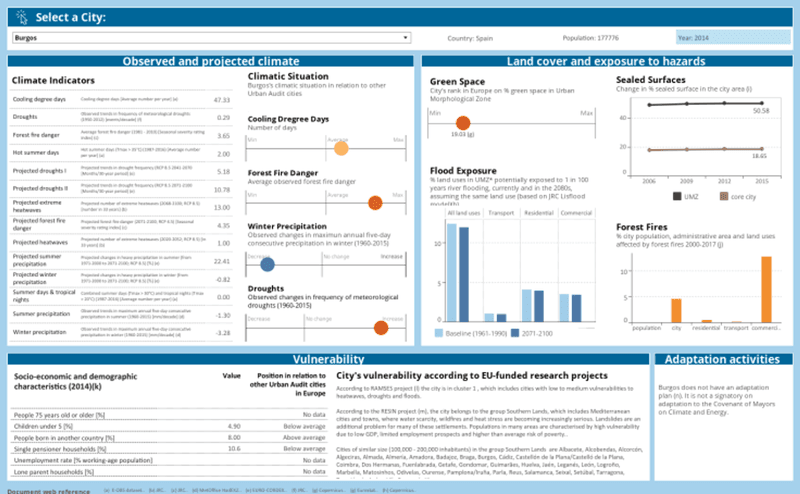
Conclusion
User analysis reports enable teams to extract actionable insights from user behavior data and share them with stakeholders from across the organization for better cross-functional alignment.
This enables them to data-driven development decisions and identify opportunities to add value to the product and improve user experience.
If you’d like to learn more about Useprilot’s analytics and reporting capabilities, book the demo!







